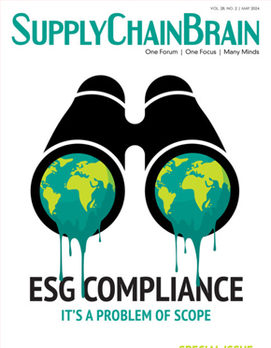
 For better or worse, the screening for explosives of all air cargo moving on passenger aircraft is now a reality. Carriers complained loudly when the Transportation Security Administration rule was announced, saying it was hugely burdensome and impractical to implement. On August 1, it went into effect anyway. Now the debate has shifted to a law mandating the 100-percent scanning and imaging of all U.S.-bound ocean containers at their ports of origin. Can we assume that the howls of criticism are equally overblown?
For better or worse, the screening for explosives of all air cargo moving on passenger aircraft is now a reality. Carriers complained loudly when the Transportation Security Administration rule was announced, saying it was hugely burdensome and impractical to implement. On August 1, it went into effect anyway. Now the debate has shifted to a law mandating the 100-percent scanning and imaging of all U.S.-bound ocean containers at their ports of origin. Can we assume that the howls of criticism are equally overblown?
Not a chance. The issue of ocean-container scanning is several orders of magnitude more complex and problematic than that of air-cargo screening. This rule, if allowed to go into effect on July 1, 2012, will cause many more problems than it solves.
It all started with the law known as the Implementing Recommendations of the 9/11 Commission Act of 2007, which established the requirement for radiation screening and image capture of every U.S. import container. Supporters of the idea, with little knowledge of the realities of maritime commerce, considered it a slam-dunk way to protect our nation from further acts of terrorism. Up to now, they argued, less than 5 percent of incoming containers have been scrutinized by U.S. Customs and Border Protection. Won't 100 percent make us 2,000 percent safer?
Those with an understanding of the issue's complexities don't think so. Last month, the Advisory Committee on Commercial Operations of Customs and Border Protection (COAC) called for repeal of the 100-percent scanning requirement. The committee, which advises the departments of Treasury and Homeland Security, is made up of representatives from carriers, customs brokers, port authorities, importers and other parts of the supply chain. Committee head Earl Agron, whose day job is vice president of security with APL, said the law "should be reevaluated in favor of risk-based measures that target high-risk shipments." Then he got more colorful. "The 100-percent question is a perpetual splinter in our finger, a royal pain," he said, "especially when we are in front of our global trading partners or any other international forum."
So what exactly is industry's problem with a law that might appear to the average citizen to be entirely reasonable? Start with the fact that lawmakers aren't just mandating the vetting of import containers through a radiation-detection portal. Approximately 98 percent of containers entering the U.S. today are scanned for radiation before they hit the streets, notes Agron. (In this and all subsequent comments, he speaks only for himself and APL - not on behalf of COAC.) He objects to the requirement that scanning be combined with X-ray-type imaging and detailed assessment of a container's contents - a technique he calls "integrated scanning."
The idea isn't a bad one, Agron says. "It's the 100-percent requirement that bothers us." Ports and carriers simply don't have the manpower and financial resources to carry out the process at that level of activity. Imagine the difficulties of separating U.S. and non-U.S. containers, as well as controlling those boxes that come off barges or arrive through transshipment. In addition, images must be assessed against manifest information, which isn't always available when a container comes through the gate. Says Agron: "The natural flow of cargo does not always cooperate."
What's more, the ability of existing technology to quickly identify shielded radioactive material "has not been demonstrated," he says. "The development of an automated process of reliably analyzing images does not exist."
That's argument enough to prompt a reconsideration of the law. What makes it even more egregious is the requirement that the scanning takes place at foreign ports of origin. Not only is the U.S. attempting to dictate what happens outside its borders; it isn't offering a reciprocal capability at U.S. ports for outbound containers. Agron says that law would necessitate a complete redesign of marine terminals the world over, especially those that weren't built to accommodate large volumes of standing equipment.
Not surprisingly, the European Union isn't happy with Uncle Sam's attempts at a unilateral imposition of new security measures. A recent European Commission working document lays out the arguments. The EC says the law fails to meet the requirement of enhancing security through internationally adopted standards, "and may become a new trade barrier."
The repercussions for global maritime transport would be immense, the report says. It estimates a cost of 430m euros (about $565.9m) for infrastructure investments, to create extra space at terminals handling U.S.-bound container traffic. In addition, operating costs at European ports would rise by more than 200m euros ($263.2m) each year, including the need for 2,200 additional staff.
The report throws in a lot of other costs, positing a total worldwide loss from the scanning law of some 17bn euros ($22.4bn). Let's look beyond the money issue, though. The EU has no plans to implement 100-percent scanning of containers at export, so any attempt by the U.S. to force the process abroad is bound to lead to international tensions and a curtailment of trade. And our transportation pipeline would be no more secure.
The notion of 100-percent scanning actually predates the conclusions of the National Commission on Terrorist Attacks Upon the United States, or 9/11 Commission. It was part of the SAFE Port Act of 2006. But that law talked about setting up pilot programs, followed by an evaluation of the lessons learned from them. Before any pilots were completed, though, the 9/11 Commission came out with its mandate, "and said you just have to do it," says Agron. This despite the fact that a pilot involving APL at one terminal at the Port of Singapore "never really got off the ground because it was so complex."
Hope lies in a bill introduced in the U.S. Senate in late July to extend the 100-percent scanning deadline to 2015, and push it back even further if the technique is shown not to be feasible by that time. And last week, three members of the House of Representatives asked Homeland Security to list by Aug. 17 all of the potential barriers to implementing the new scanning regime. So it's likely that more rational heads will prevail. No one disagrees about the need for stricter security measures in global trade. But a truly workable scheme must take into account the degree of risk attached to a given port or region. As Agron puts it: "I don't think there's a one-size-fits-all solution." Let's hope Congress agrees.
- Robert J. Bowman, SupplyChainBrain
Comment on This Article


.jpg?height=100&t=1715228265&width=150)



